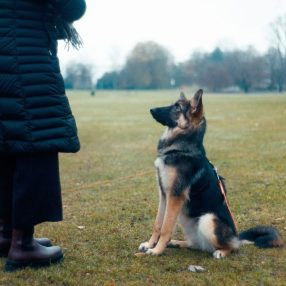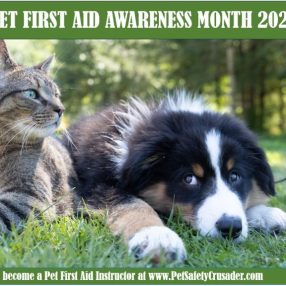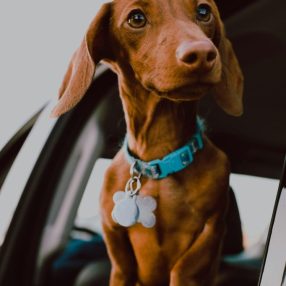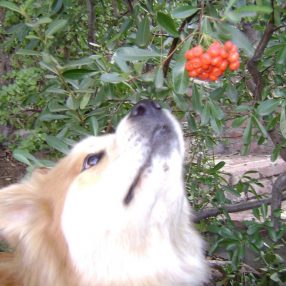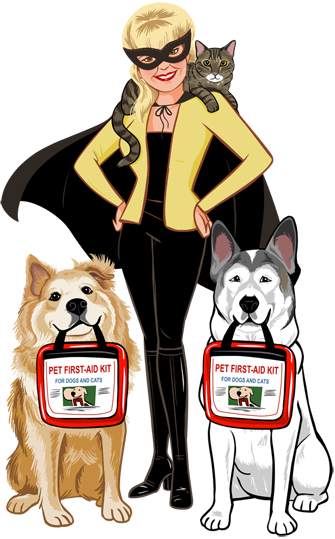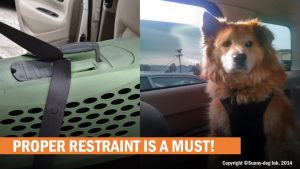
January 2nd is National Pet Travel Safety Day, but it is also a great time to assess and upgrade best practices for transporting your dog or cat safely. Whether you travel to the vet or groomer, head to the park or hit the road for a vacation, take precautions as thousands of animals are injured or die in car accidents every year. If a 50-lbs. dog is riding in a car moving 30 mph, he will feel as though nine 170-lbs. men pushed him against a brick wall if he is thrown during a car accident (1,500 lbs. of force). Since a body in motion will stay in motion until acted upon by an outside force, even after brakes are applied, an unrestrained pet will continue to move 30, 40, 50 mph or more until something stops him. Sadly, what stops him may be the dash board, seat back or windshield, all of which can cause devastating injury.
If the pet survives the accident but is not restrained, he may escape through a window or door, broken or opened by the impact, only to end up being hit by an on-coming vehicle.
According to the American Automobile Association (AAA), animals moving around in cars are the third worst distraction to drivers, ranking behind children and cell phones. Additionally, if you are injured in an accident, your protective Chihuahua, Poodle or Rottweiler might prevent paramedics from quickly offering aid out of fear of being bitten, so Animal Control may first need to be called to confine your pet.Their protectiveness may delay emergency personnel from providing you much-needed medical assistance, so all around…restraining your pets in your motor vehicles is a good thing. Just do not leave them alone!
Ways to Keep Pets Safe
Buckle-up Fido
Buckle Fido into a pet-specific seatbelt, even if it’s only a ride around the block. Dog restraints easily attach to your vehicle’s seat belt buckle or strap, or may hook to a guy-wire or bracket. Precisely measure harnesses, and learn about body-shape specifics, so that you choose the safest, best-fitting device. Some gadgets keep pets upright, while others make it easy for your dog to turn around and lie down.
Take into consideration your pooch’s current health issues as arthritis, sore hips and joints may be aggravated depending on where the harness hugs his body. Wire cages or plastic crates are also good choices as they shield both cats and dogs from falling objects, but pets can get tossed around inside. Cushion the crate, and secure it well to prevent it from being tossed during an impact or sudden stop.” Visit The Center for Pet Safety for tested and approved safety gear.
Body Parts INSIDE
Gravel, tree branches, dust and pollen can irritate canine eyes, and even the breeze can dry out the cornea causing infection, injury or trauma. If a canine head hangs out the window while a paw steps on the power button, a window could close on his neck!
Spots to Avoid
The Passenger Seat – If the airbag deploys, small pets generally receive spinal injuries due to the 200 mph at which the bag hits them. Larger dogs often end up with severed tongues resulting in life-threatening blood loss.
Bed of a Pick-up Truck or any other un-sheltered space – Pets should never be subjected to hard, often scorching and unsteady surfaces where bone, joint and bruising injuries could occur. Dogs may get ‘scalped’ when falling through the back window of a truck cab, so regardless of local laws, don’t put your precious pooch in harm’s way.
If truck bed transport is absolutely necessary, be sure that:
- The space is enclosed or has side and tail rails no less than 48 inches high, extending vertically from the bed.
- The dog is cross-tethered to the vehicle using a harness that encircles his shoulders and rib cage. Never attach tethering or a leash to a neck collar in a moving vehicle.
- Your dog is protected by a secured container or cage that cannot fall or slide about and provides cushioning.
- Healthy temperature and air flow
Everyone Calm
Work together to acclimate your dog or cat by taking short trips first and keeping voices low and calm. Pet-friendly musical CDs are available that can relax the whole family, while aromatherapy (dogs only) may spritz anxiety away. Mists can also be massaged onto the outer ears or abdomen, or sprayed on a favorite bandana or blanket. Tangerine, lavender and rose geranium produce a calming effect, bergamot lessens anxiety and ginger decreases stomach upset.
Reduce Motion Sickness
If your pet gets queasy, feed a couple ginger snap cookies 20-minutes before embarking. If using pure ginger capsules, 100 mg per 25 lbs. of body weight 30 minutes before departure is advised but speak to your veterinarian for more tips.
- Give your pet 4-6 hours after mealtime before hitting the road.
- Face the crate forward. If you must turn it in another direction for safety sake, cover the carrier to prevent your pet looking out in a non-forward moving direction however, make sure you dog has plenty of good ventilation.
- Some cars vibrate more or are more conducive to motion sickness than others, so let Rover pick his favorite if you have multiple vehicles.
- Keep the car cool inside, and prevent harsh sunlight from directly shining on your pooch.
Pit Stops
When making stops along the way, NEVER EVER leave your dog, cat, kid or other animal alone in the car for even a few minutes. Despite windows rolled down, cars get very hot, very fast, and your best friend could suffer brain injury, kidney or liver failure, or death! When it’s a comfortable 75°F outside, internal car temperatures in a parked care can rise to 120°F, even with windows slightly open. Always keep someone in the car with your dog or don’t make the stop. It’s PAWSitively NOT worth the risk.


